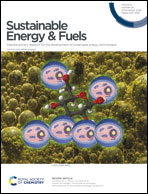A dual-strategy of interface and reconstruction engineering to boost efficient alkaline water and seawater oxidation†
Abstract
Seawater electrolysis under alkaline conditions represents a sustainable approach to the mass production of carbon-neutral hydrogen energy. However, the lack of efficient electrocatalysts restricts the development of this technology. Herein, core–shell-structured NiMoO4@NiFe LDH arrays with simultaneous interface and reconstruction engineering are reported as an efficient OER electrocatalyst for alkaline seawater electrolysis. The catalyst's open and hierarchical architecture, along with the excellent synergistic effects, allows for abundant active sites, high intrinsic activity and effective charge transfer. Specifically, it only required low overpotentials of 251 and 349 mV to attain current densities of 100 and 500 mA cm−2, respectively, along with impressive long-term durability over 80 h and nearly 100% faradaic efficiency. Various ex situ and in situ techniques substantiate the deep reconstruction behavior of the electrocatalyst, including fast dissolution of MoO42− anions and in situ generation of active NiFeOOH species. This work highlights that interface and reconstruction engineering are efficient strategies to fabricate advanced OER electrocatalysts.



 Please wait while we load your content...
Please wait while we load your content...